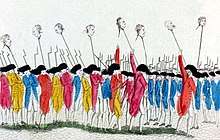Age of Revolution


_p089_Murder_of_George_Crawford.jpg)
The Age of Revolution is the period from approximately 1774 to 1849 in which a number of significant revolutionary movements occurred in many parts of Europe and the Americas.[1] The period is noted for the change in government from absolutist monarchies to constitutionalist states and republics. The Age of Revolution includes the American Revolution, the French Revolution, the Irish Rebellion of 1798, the Haitian Revolution, the revolt of slaves in Latin America, the First Italian War of Independence, Sicilian revolution of 1848, and the 1848 revolutions in Italy; and the independence movements of Spanish and Portuguese colonies in Latin America. In a way, it includes the Industrial Revolution. The period would generally weaken the imperialist European states, who would lose major assets throughout the New World. For the British, the loss of the Thirteen Colonies would bring a change in direction for the British Empire, with Asia and the Pacific becoming new targets for expansion.
Industrial Revolution
The Industrial Revolution was the transition to new manufacturing processes in the period from about 1760 to sometime between 1820 and 1840. It marks a major turning point in history; almost every aspect of daily life was influenced in some way. In particular, average income and population began to exhibit unprecedented sustained growth.
American Revolution (1775–1783)
The Thirteen Colonies of British America famously became independent in the American Revolution of 1776. The movement was the first European colony to claim independence and saw the application of elected government, a constitution, and limited civil rights, none of which were unheard of but were unique in their combination. This was the birth of the United States of America.
French Revolution (1789–1799)
The French Revolution was a period of radical social and political upheaval in France from 1789 to 1799 that profoundly affected French and modern history, marking the decline of powerful monarchies and churches and the rise of democracy and nationalism. Popular resentment of the privileges enjoyed by the clergy and aristocracy grew amidst an economic crisis following two expensive wars and years of bad harvests, motivating demands for change. These were couched in terms of Enlightenment ideals and caused the convocation of the Estates-General in May 1789
Haitian Revolution (1791–1804)
The Haitian Revolution was a slave revolt in the French colony of Saint-Domingue, which culminated in the elimination of slavery there and the founding of the Republic of Haiti. The Haitian Revolution was the only slave revolt which led to the founding of a state. Furthermore, it is generally considered the most successful slave rebellion ever to have occurred and as a defining moment in the histories of both Europe and the Americas. The rebellion began with a revolt of black African slaves in August 1791. It ended in November 1803 with the French defeat at the battle of Vertières. Haiti became an independent country on January 1, 1804.
United Irishmen Rebellion (1798)
In 1798, Irishmen rose against British Rule in Ireland in the hopes of creating a Republic. The rebellion was initiated by the Society of United Irishmen and led by Theobald Wolfe Tone. They rebelled against the government for a number of reasons but most notably due to the sectarian nature of British Rule, which upheld the Penal Laws that discrimated against Catholics and Presbyterians in Irish society. The rebellion failed and led to the Act of Union in 1801.
Serbian Revolution (1804–1835)
The Serbian Revolution was a national uprising and constitutional change in Serbia that took place between 1804 and 1835, during which the territory evolved from an Ottoman province into a rebel territory, a constitutional monarchy, and finally the modern Serbian state. The first part of the period, from 1804 to 1815, was marked by a violent struggle for independence from the Ottoman Empire with two armed uprisings taking place, ending with a ceasefire. During the later period (1815–1835) a peaceful consolidation of political power developed in the increasingly autonomous Serbia, culminating in the recognition of the right to hereditary rule by Serbian princes in 1830 and 1833 and the territorial expansion of the young monarchy. The adoption of the first written Constitution in 1835 abolished feudalism and serfdom, and made the country suzerain. The term "Serbian Revolution" was coined by a German academic historiographer, Leopold von Ranke, in his book Die Serbische Revolution, published in 1829. These events marked the foundation of the modern Principality of Serbia.
Scholars have characterized the Serbian War of Independence and subsequent national liberation as a revolution because the uprisings were started by broad masses of rural Serbian people who were in severe class conflict with the Turkish landowners as a political and economic masters at the same time, similar to Greece in 1821–1832.
Latin American Wars of Independence (1808–1833)
Latin America experienced independence revolutions in the early 19th century that separated the colonies from Spain and Portugal, creating new nations. These movements were generally led by the ethnically Spanish but locally born Creole class; these were often wealthy citizens that held high positions of power but were still poorly respected by the European-born Spaniards. One such Creole was Simón Bolívar, who led several revolutions throughout South America and helped establish Gran Colombia. Another important figure was José de San Martín, who helped create the United Provinces of Rio de la Plata and became the first president of Peru. Some Latin American revolts, such as the Haitian Revolution, were led by slaves.
Greek War of Independence (1821–1832)
Greece in the early part of the 1800s was under the rule of the Ottoman Empire. A series of revolts, starting in 1821, began the conflict. The Ottoman Empire sent in forces to suppress the revolts. By 1827, forces from Russia, Great Britain, and France entered the conflict, helping the Greeks drive the Turkish forces off the Peloponnese Peninsula. The Turks finally recognized Greece as a free nation in May 1832.
Revolutions of 1820
Revolutions of 1830
Revolutions of 1848
The European Revolutions of 1848, known in some countries as the Spring of Nations, Springtime of the Peoples or the Year of Revolution, were a series of political upheavals throughout Europe in 1848. It remains the most widespread revolutionary wave in European history, but within a year, reactionary forces had regained control, and the revolutions collapsed.
Taiping Revolution (1850-1864)
The Taiping Rebellion was a revolt against the Qing dynasty in China, fought with religious conviction over regional economic conditions, and lasting from 1850 to 1864. The Taiping forces were run as a cult-like group called the God Worshipping Society by self-proclaimed prophet Hong Xiuquan, and resulted in the rebels seizing the city of Nanjing for a decade. The Taiping Rebellion eventually failed, however, and led to the deaths of more than 20 million people.
See also
References
- ↑ Matson, Cathy (July 2005). "The Atlantic Economy in an Era of Revolutions: An Introduction". William and Mary Quarterly.